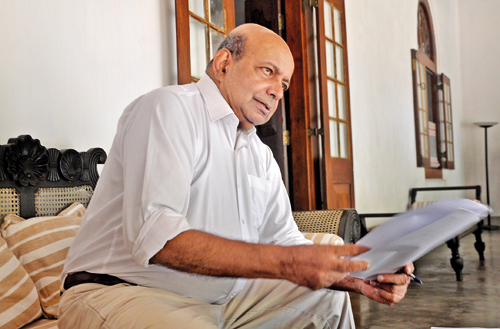He dug deep to blaze a trail
It was with some trepidation that I rang Eknaligoda Walawwa. Even though I knew Dr Siran Upendra Deraniyagala to be an artist and musician as well as an archaeologist (always a humane breed, these latter-poets with hoary stone), I was nervous of disturbing the peace of that old Kandyan manor on a misty Monday morning.

At home: Dr. Siran Deraniyagala at Eknaligoda walawwa (file photo by Nilan Maligaspe)
The renowned prehistorian and archaeologist trained in the UK and Harvard, Dr. Siran, however, turned out to be as courteous as he was genteel, and answered my questions on the Nittaewo, the so-called lost pygmies of Ceylon- a subject that had fascinated me since childhood and one which I was researching for an article – with infinite patience.
Ruling out the idea of an authentic pygmy species (given that our island was connected to India till recent geological times, unlike Flores, separated since the beginning of time, and the home of the Flores Hobbit) he ventured a theory of his own: that this was probably a rival group of Veddahs ‘smoked out’- and villainized posthumously.
Despite a slightly laboured voice, he spoke with authority. So it was shocking to hear, hardly two weeks later, that the doyen of Lankan archaeologists had passed away.
That Dr Deraniyagala preferred the maternal walawwa in Kuruvita with its vast meda midula, colonnaded verandahs and old Sinhala ulu roofs to a house in Colombo 7 (where most of his relatives lived) said a lot about him.
He came from a long line of scholars. Grandfather Sir Paul E. Pieris, the first Asian to enter Trinity College, Cambridge, was the Public Trustee of Ceylon and one of the finest historians on Ceylon of the modern period. Sir Paul Pieris’ eldest, Dr. P. E. P. Deraniyagala, an equally eminent prehistorian who specialised in zoology and paleontology (all the while being an artist) and was the Director of the National Museum for many years.
A third generation Thomian, Siran by 17 entered Trinity College, Cambridge and obtained a BA in Architecture and Sanskrit. Completing his postgraduate diploma at the Institute of Archaeology, London in 1965, he was awarded the prestigious Gordon Childe Prize.
Amongst his teachers at London and (later) Harvard were Sir Harold Bailey, K. de B. Codrington, Frederick Zeuner, Christoph von Fuerer-Heimendorf and Hallam Movius.
Returning home overland, he hitchhiked from London to India through Iran and Afghanistan and spent a year in India working with prehistorians there before letting his native earth yield its secrets to his fingers. It was the early periods, especially the prehistoric that fascinated him.
In 1968 he joined the Archaeological Survey Department of Sri Lanka as Assistant Commissioner in charge of scientific excavations.
His major work would be the tome based on his PhD thesis submitted to Harvard in 1988, titled The Prehistory of Sri Lanka: An Ecological Perspective. Published by Harvard in 1988, it was slightly revised and republished by the Department of Archaeology in 1992.
One of his momentous discoveries was in Anuradhapura, regarding the beginnings of writing. The established textbook version was that earliest writing in South Asia comes from the Asokan period. In 1988 however Dr Deraniyagala found potsherds with Brahmi inscriptions from 600-500 BC in the midst of excavations, and this was confirmed in South India in 2015 with discoveries of pottery with writing as old as 490 BC.
Amongst the major collaborative projects by Dr Deraniyagala was the bioanthropological study with Dr Diane Hawkey from the State University of Arizona, where skeletal remains highlighted the relationship between the Sri Lankan prehistoric humans (Balangoda Man) and the Australians and Melanesians on one hand and tribal groups in India and recent Veddahs. It also revealed genetic similarities between the people of the Indus Civilization in North West India and recent Sri Lankan material.
Director-General at the Department of Archaeology from 1992 to 2001, Dr Deraniyagala will always be looked up to by all Sri Lankan archaeologists as the man who pioneered the scientific stratified excavation process in the country, and blazed a trail for coming generations.


